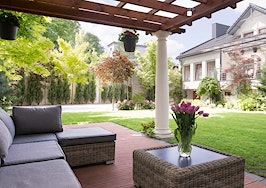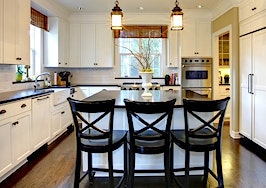- Recognizing and identifying home design styles can be tricky. Here's a few easy ways to recognize nine of the most popular.
For most buyers today, a home’s architectural style usually isn’t a “make or break” feature, and is ranked below other features and attributes such as the functionality of the indoor layout, energy efficiency, smart home technology capabilities, and where the home is related to work and school.
But it never hurts to be able to quickly recognize and identify common home styles to better assist buyers who are sticklers for design.
Ranch
Defining features: This style is often associated with being the “quintessential” American home — it’s open and wide floor plan, attached garage and easy-to-access one-story layout made it the most popular style in the 40s and 50s as American families began moving out to the suburbs. Ranch-style homes have pitched roofs, wood or brick exteriors, and sliding doors that lead to large backyard spaces.
Lastly, the homes are often shaped like “L”s or “U”s.

rSnapshotPhotos / Shutterstock
Where is it most popular? Ranch style homes are most plentiful in the West, and more specifically California, hence why they’re also called “California Ranch” style homes.
Craftsman
Defining features: Architect and furniture designer Gustav Stickley is credited with creating the Craftsman (also known as Bungalow) style home during the Arts and Crafts Movement of the late 1800s and early 1900s.
Stickley said this style of home is “a house reduced to it’s simplest form… its low, broad proportions and absolute lack of ornamentation gives it a character so natural and unaffected that it seems to… blend with any landscape.”
Craftsman style homes are known for overhanging eaves, a low gabled roof, expansive front porches and tapered columns. The exterior is often made of a mix of wood, stucco, and stone, giving it a natural, understated look. The interior often has an open floor plan complete with built-in furniture, i.e. bookshelves, fireplaces and exposed wood beams.

Artazum / Shutterstock.com
Where is it most popular? Craftsman style homes are consistently one of the most popular home styles no matter what region you’re in, but they get the most attention in the Midwest.
Cape Cod
Defining features: The Cape Cod style is based on the thatched cottages of England and originated with the colonialists of the early 1600s. This style of home is known for a wide, sturdy chimney, steep roofs and shutter windows — perfect for combating harsh Northeastern winters.
Cape Cod-style homes are often one story, and the exteriors are often made of clapboard or brick.

rSnapshotPhotos / Shutterstock
Where is it most popular? The Northeastern, New England region.
Shotgun
Defining Features: It’s said this style of home got its unique name from the fact you could stand in the doorway and shoot a bullet through the backdoor. Shotgun homes are slim and rectangular, and the rooms lead straight from one room to another until you reach the back of the home. Shotgun homes usually have a front porch and can be spruced up on the outside with brightly colored paint and ornamental decorations.
This style of home was popular in the early 1900s due to the low cost and quick construction times.

cdrin / Shutterstock
Where is it most popular? This home is mostly seen in the South, and specifically, New Orleans where residents took the homes to another level with bright paint, highly stylized window and door ornaments and other striking decorative features.
Tudor
Defining features: Just like the Cape Cod style home, Tudor style homes find their origins in England. Tudors are often two-stories and feature multiple multi-gabled roofs and timber framing. The exterior is made of brick or stone, and the home features large, gorgeous casement windows and sturdy chimneys.
This style saw its heyday in the 1920s and 30s, but it remains a mainstay in many historical neighborhoods across the U.S.

Susan Law Cain / Shutterstock
Where is it most popular? This home is the most popular in the Northeast since it’s built to withstand harsh winter weather with ease.
Victorian
Defining features: Victorian-style homes began their reign during the mid-1800s, when Queen Victoria took the throne in England. These homes are usually two (even three) stories and are known for elaborate brackets, spindles and patterned shingles. These homes also feature large porches, multiple wings and bays and towers.

Buckeye Sailboat
Where is it most popular? Victorian homes can be found just about anywhere, but the cities of San Francisco and New Orleans are most famous for an abundance of well-kept historical Victorian homes.
Art Deco
Defining Features: Art Deco gained its popularity in the 1930s and reflected the modern, glamorous “Old Hollywood” feel of the time. The Art Deco style is known for its flat roof, stucco walls, geometric details and bright pops of color.
This style is mainly used for commercial buildings, but you’ll be able to find homes that boast this style.

Rachael Burke / Shutterstock
Where is it most popular? Miami is known for an abundance of Art Deco style commercial and residential properties.
Mediterranean
Defining Features: This style of home is modeled after the “hacienda style” that originated in Central and Latin America. They also pull influences from Italian, Spanish and Greek architecture. Most Mediterranean style homes have red tiles with plastered exteriors and feature lush terraces, porticos, balconies and arches.

cdrin / Shutterstock
Where is it most popular? California and Florida, where the weather most mirrors the climate of the Mediterranean.
Contemporary
Defining Features: Architects vary on how they define contemporary homes — some say it simply refers to the current building style that favors energy efficiency, sustainable building materials, and blended living spaces.

Breadmaker / Shutterstock
Others say it refers to a building style that was popular from the 1950s to 70s. This version of the Contemporary style is known for tall windows, funky exteriors that had a medley of stone, brick and wood, and featured exposed outdoor beams.
Where is it most popular? Everywhere!
This article includes information from Realtor.org, DIY, and HGTV.












